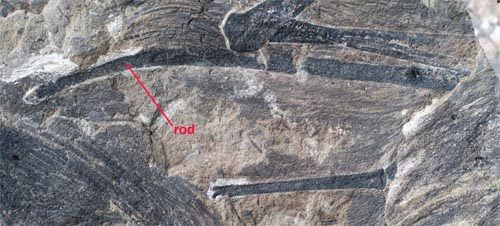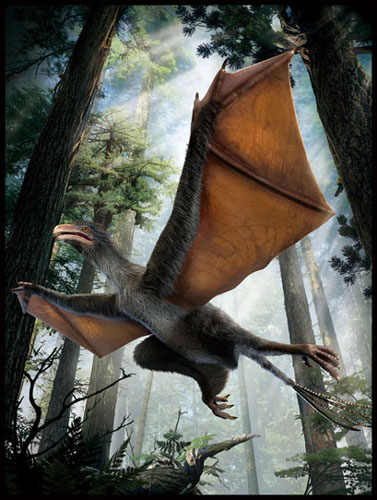Bizarre Jurassic Dinosaur with Membranous Wings

Fig.1 Only known specimen of the new dinosaur Yi qi, an articulated partial skeleton with associated soft tissue preserved. (Image by ZHENG Xiaoting)

Fig.2 Sheet-like membranous tissues preserved around the tip of the right rod-like bone indicated by the red arrow and stiff filamentous feathers preserved elsewhere in the image (Image by ZHENG Xiaoting)

Fig.3 An artist's depiction of the Yi qi dinosaur (Image by by Dinostar Co. Ltd)
A research team led by Professor XU Xing, Institute of Vertebrate Paleontology and Paleoanthropology (IVPP), Chinese Academy of Sciences, and ZHENG Xiaoting, Shandong Tianyu Museum of Nature, reported a new scansoriopterygid theropod, Yi qi gen. et sp. nov., based on a new specimen from the Middle–Upper Jurassic period Tiaojishan Formation of Hebei Province, China. This small feathered dinosaur has forelimb bones thought to support bat-like aerofoil membranes, and might have been able to glide or fly short distances. The finding reported online 29 April in Nature increases the morphological disparity known to exist among dinosaurs, suggesting there was more evolutionary experimentation in dinosaur flight before they evolved into birds than we thought.
Yi qi is an articulated partial skeleton with associated soft tissue preserved on a slab and counter slab which was housed at the Shandong Tianyu Museum of Nature. The generic and specific names are derived from Mandarin Yi (wing) and qi (strange), respectively, referring to the bizarre wings of this animal.
Yi is inferred to be an adult on the basis of the closed neurocentral sutures of the visible vertebrae. Its body mass is estimated to be approximately 380 g, using an empirical equation.
Yi is nested phylogenetically among winged theropods but has large stiff filamentous feathers of an unusual type on both the forelimb and hindlimb. Yi is a scansoriopterygid theropod distinguishable from other members in having a unique combination of features, but the most striking feature of Yi is the presence of an anomalous, slightly curved, distally tapered, rod-like structure associated with each wrist and apparently extending from the ulnar side of the carpus.
Energy dispersive spectrometry (EDS) analysis of the elemental composition of the rod extending from the right wrist confirms that it is a bone (or possibly a skeletal element composed of calcified cartilage) and not a soft-tissue structure. No equivalent of the rod-like bone is known in any other dinosaur even outside Theropoda, but similar structures are present in a diverse array of extant and extinct flying or gliding tetrapod groups, including pterosaurs, bats and many gliding mammals.
"Most surprisingly, Yi has a long rod-like bone extending from each wrist, and patches of membranous tissue preserved between the rod-like bones and the manual digits. Analogous features are unknown in any dinosaur but occur in various flying and gliding tetrapods, suggesting the intriguing possibility that Yi had membranous aerodynamic surfaces totally different from the archetypal feathered wings of birds and their closest relatives”, said study coauthor Dr.Corwin Sullivan of the IVPP.
Several patches of membranous soft tissue are exposed around the styliform element and digits in both hands. The tissue has a sheet-like appearance, making it clearly distinguishable from the individual filaments or small groups of filaments that represent feathers, and in some areas displays prominent ripple-like striations that may represent either fibres or closely spaced folds. The membranous tissue does not closely resemble any type of integumentary structure previously reported in theropods from the Mesozoic era deposits of northeastern China.
Researchers examined the integumentary structures using scanning electron microscopy, and found what we interpret as preserved melanosomes on both feathers and membranous tissue patches. The melanosomes are highly variable in size, shape and density. The membranous tissue contains only small phaeomelanosomes, unlike the filamentous feathers in which eumelanosomes predominate and relatively few phaeomelanosomes are present.
The mode of aerial locomotion that might have been used by Yi is difficult to reconstruct on the basis of present evidence. Yi may have been capable of flapping flight or only of gliding, or may have combined the two locomotor styles as in many extant birds and some bats, said XU Xing. There are some indications that Yi may have relied more on gliding than on flapping, including the lack of strongly expanded muscle attachment surfaces on the forelimb bones and the possibility that the unwieldy styliform element would have interfered with the rapid oscillations and rotations of the distal part of the forelimb needed for efficient flapping flight, but the mode of aerial locomotion that is most likely for Yi remains uncertain.
"Regardless, the evident occurrence of a membranous wing represents an unexpected aerodynamic innovation close to the origin of birds, and highlights the breadth of flight-related morphological experimentation that took place in the early stages of paravian history”, said XU Xing.
This research was funded by the National Natural Science Foundation of China and Major Basic Research Projects of the Ministry of Science and Technology, China.
Download attachments: